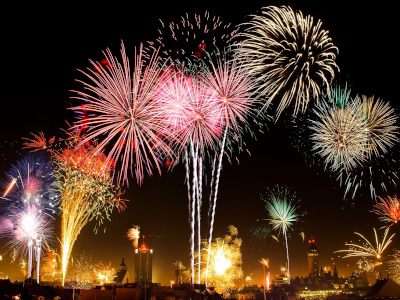Fireworks belong to a class of low-explosive pyrotechnic devises. They are used for aesthetic and entertainment purposes. They are usually used all together in one big display, and they can be used only outside. Fireworks are usually designed to burn and sparkle with different colours, like red, orange, yellow, green, silver, and so on. Fireworks are usually used at the end of big events, like New Year’s Eve, Independence Day celebrations, concerts, birthdays and so on. Fireworks are divided mainly into two classes: ground and aerial.
Ground fireworks are firecrackers and sparkles. Firecrackers are made with rolled-up paper, which is filled with gunpowder. You can also find in them flash paper and a fuse. In sparkles, there is no explosive material. The dust that shines bright when you burn a sparkle is made out of different metals. For example, aluminium, iron, steel, zinc, or magnesium.
Aerial fireworks are the ones that we see in the sky. They are made as a shell, and they have four parts. The paper in the shell is pasted. There is also a fuse, which helps the shell reach its desired heights before it explodes. At the centre of the shell, there is a bursting charge that helps the shell break apart, and due to that, everything is spilled everywhere. Inside the shell, there are also small sparkles like spheres also known as stars. The shells are launched from the ground from small pipes filled with black powder. The firework pattern depends on the way the stars are arranged inside the shells. The colours are made chemically. For example, if you see yellow fireworks, it means that sodium is used for them.
Fireworks were invented in China, and China is still the largest manufacturer.
Historians haven’t agreed on the exact date when the fireworks were invented, but it probably was more than 2000 years ago. It probably started with the Tang Dynasty. During this time, gunpowder was invented. Others think that it was discovered during the Song Dynasty between 960 and 1279.
There is a story that says that the discovery was made by accident by a Chinese cook. He mixed together charcoal, sulphur, and saltpetre. This mixture burns very well, and if it is done in a closed space, then it explodes. It was about 1000 years ago when Chinese monk Li Tian invented the firecrackers. And nowadays, on April 18, Chinese people are celebrating the invention of firecrackers.
In China, it is believed that fireworks have power against evil spirits and demons because they are scared of loud sounds.
It is largely believed that in the 13th century, Marco Polo was the one who introduced gunpowder to Europe. Other historians believe that it was done by the Crusaders when they returned from their travels in the Middle East. They started to use gunpowder in the military. During the Renaissance era, two different pyrotechnic schools emerged: Italian and German. The Italians focused more on nice effects to create beautiful displays. The Germans focused more on the scientific part. In the mid-17th century, fireworks were already used for entertainment.
England also started to use fireworks for celebrations. In 1487, fireworks were used during the coronation of Elizabeth of York. Fireworks became very popular during the reign of Queen Elizabeth I. Also, William Shakespeare mentioned fireworks in several of his plays.
In the U.S., the fireworks were part of the very first Independence Day, on July 4, 1776. They were brought there by Europeans, since they liked them a lot. In the 18th century, politicians also used fireworks to attract crowds to come and listen to their speeches.
Fireworks were then and are also now used to bring luck and happiness and to scare away evil spirits.
Fireworks have to be handled properly, if not, they can cause harm. They can cause burn scars and wounds, but they can also cause crate fires. The use of fireworks is legally restricted in many countries.
Animals are usually afraid of fireworks. In an attempt to run away, the animals can insure themselves. For example, dogs can experience distress and anxiety during the fireworks. Fireworks also affect birds, especially geese, eagles, and others. There is a study that shows that about 1000 times more birds are in flight on New Year’s Eve than on average nights. Frightened birds can fly up to 500 km away from their nesting places and abandon their chicks completely.

Sources:
https://en.wikipedia.org/wiki/Fireworks
https://wonderopolis.org/wonder/how-are-fireworks-made
https://www.americanpyro.com/history-of-fireworks
https://epicfireworks.com/pages/the-evolution-of-fireworks
https://www.fireworks.co.uk/firework-history/
https://www.nationalgeographic.com/culture/article/how-fireworks-came-to-america
